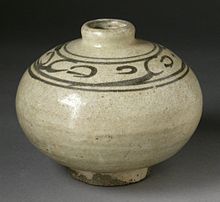Tao Thuriang (Sukhothai)
Tao Thuriang (also Tao Thu Riang or Tao Turiang , Thai เตาทุเรียง , English Thuriang Kilns ) refers to a former pottery district on the northern edge of the historical old town Sukhothai in the UNESCO World Heritage Site Sukhothai Historical Park in Thailand .
location
The ruins of the former pottery district are located a good 800 meters outside the old city walls in a bushy area, immediately north of the moat surrounding Wat Phra Phai Luang . In the east-west extension they extend over a length of around 700 meters, in the north-south extension the width of the area varies around 100 meters. Wat Tao Thuriang is located in the middle of the pottery area . The kiln ruins that are most worth seeing are in different conservation and overgrowth states west of the Wats.
Findings
A total of 51 kilns were archaeologically proven in these areas, but only eleven of them had the conditions to reach the high temperatures required for the production of the extraordinary Sukhothai and Sawankhalok goods , which are traded across Asia . In addition to this high-quality stoneware , earthenware was also produced in large numbers , for which lower temperatures are sufficient. A total of around 100 kilns is suspected. They were probably operated from the late 13th century to the second half of the 16th century.
- Pottery Kilns in Sukhothai Historical Park
technology
For the production of the earthenware, simple, round kilns with linear upward-drawing air (English: up-draft kilns ) were used. To produce Sukhothai and Sawankhalok goods, three-part ovens with circulating air (English cross-draft kilns ) were required . The foremost and deepest area of the three-part furnace structure was the furnace chamber, followed by the largest, higher-level, oval and domed room with the material to be fired. At the end of this room there was a flue system that led to a chimney. The "Kilns" developed over time from relatively simple caves dug into the earth via intermediate forms to fully constructed, above-ground brick ovens. The last variant dominates the findings in Sukhothai. Since the younger ones were placed on top of the older ones, well visible mounds of earth were still formed in the area today.
literature
- Roxanna M. Brown : The Sukhothai and Sawankhalok Kilns . In: Dies .: The Ceramics of South-East Asia. Their Dating and Identification. 2nd edition. Art Media Resources, Chicago 2000, ISBN 1-878529-70-6 , pp. 56-80.
- Don Hein: Ceramic Kiln Lineages in Mainland Southeast Asia . Freer Gallery of Art and Arthur M. Sackler Gallery, Washington, 2008.
- Don Hein, Peter Burns & Dick Richards: An Alternative View on the Origins of Ceramics Production at Si Satchanalai and Sukhothai, Thailand . SPAFA Digest 7.1 Bangkok 1986, ISSN 0125-7099 , pp. 22-33.
- John M. Miksic (Ed.): Southeast Asian Ceramics. New Light On Old Pottery . Southeast Asian Ceramic Society, Singapore 2009, ISBN 978-981-4260-13-8 .
- Dawn F. Rooney : A Field Guide to Glazed Thai Ceramics . In: Asian Perspectives Vol. 28, 2, 1990, ISSN 1535-8283 , pp. 125-144.
- Dawn F. Rooney: Ceramics of Seduction. Glazed Wares of Southeast Asia . River Books, Bangkok 2013, ISBN 978-616-7339-39-9 .
- Dawn F. Rooney: Folk Pottery in South-East Asia . Oxford University Press, Singapore 1987, ISBN 0-19-588866-9 .
- Dawn F. Rooney: Ancient Sukhothai. Thailand's Cultural Heritage . River Books, Bangkok 2008, ISBN 978-974-9863-42-8 , pp. 54-67 and 109.
- Thanyakarn Wong-on, Pariwat Thammapreechakorn: Sukhothai and Si Satchanalai Ceramics. Inspiration and Realization . Thanombutra School, Bangkok 2012, ISBN 978-616-3218-55-1 .
- Hiram W. Woodward Jr.: The Dating of Sukhothai and Sawankhalok Ceramics. Some considerations. In: Journal of the Siam Society Vol. 66, 1, 1966, ISSN 0857-7099 , pp. 1-7.
Web links
Individual evidence
- ↑ Wat Tao Thuriang: 17 ° 1 ′ 56.54 ″ N , 99 ° 41 ′ 55.18 ″ E
- ↑ a b c Dawn F. Rooney : Ancient Sukhothai. Thailand's Cultural Heritage . River Books, Bangkok 2008, ISBN 978-974-9863-42-8 , p. 109.
- ^ Roxanna M. Brown : The Sukhothai and Sawankhalok Kilns . In: Dies .: The Ceramics of South-East Asia. Their Dating and Identification. 2nd edition. Art Media Resources, Chicago 2000, ISBN 1-878529-70-6 , pp. 56-80.
- ^ Dawn F. Rooney: A Field Guide to Glazed Thai Ceramics . Asian Perspectives, Vol. 28, No. 2. University of Hawaii Press, 1990, pp. 125-144.
- ^ Don Hein: Ceramic Kiln Lineages in Mainland Southeast Asia . Freer Gallery of Art and Arthur M. Sackler Gallery, Washington, 2008.
Coordinates: 17 ° 1 ′ 56.6 ″ N , 99 ° 41 ′ 49.4 ″ E






